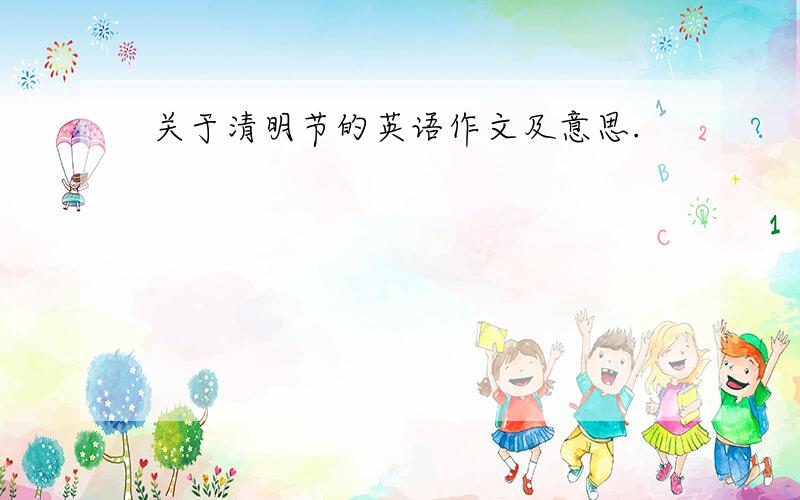关于清明节的英语作文及意思.
来源:学生作业帮助网 编辑:作业帮 时间:2024/11/29 17:53:41

关于清明节的英语作文及意思.
关于清明节的英语作文及意思.
关于清明节的英语作文及意思.
1、Its Chinese name "Qing Ming" literally means "Clear Brightness," hinting at its importance as a celebration of Spring.Similar to the spring festivals of other cultures,Tomb Sweeping Day celebrates the rebirth of nature,while marking the beginning of the planting season and other outdoor activities.
清明节,又叫踏青节,正是春光明媚草木吐绿的时节,也正是人们春游的好时候,所以古人有清明踏青,并开展一系列体育活动的的习俗.直到今天,清明节祭拜祖先,悼念已逝的亲人的习俗仍很盛行.
2、In ancient times,people celebrated Qing Ming Jie with dancing,singing,picnics,and kite flying.Colored boiled eggs would be broken to symbolize the opening of life.
3、One theory is that since any number of ghosts rome around a grave area,the less appealing food will be consumed by the ancestors,and not be plundered by strangers.
清明节扫墓英语作文
Last Qingming Festival,i return home to worship my grandfather.Qingming Festival is a folk Festival.In the past,In the past,the Qingming Festival was called "Arbor Day".But Today,Chinese visit their family graves to tend to any underbrush that has grown.Weeds are pulled,and dirt swept away,and the family will set out offerings of food and spirit money.Unlike the sacrifices at a family's home altar,the offerings at the tomb usually consist of dry,bland food.One theory is that since any number of ghosts rome around a grave area,the less appealing food will be consumed by the ancestors,and not be plundered by strangers.
With the passing of time,this celebration of life became a day to the honor past ancestors.Following folk religion,the Chinese believed that the spirits of deceased ancestors looked after the family.Sacrifices of food and spirit money could keep them happy,and the family would prosper through good harvests and more children.分享给你的朋友吧:人人网新浪微博
Its Chinese name "Qing Ming" literally means "Clear Brightness," hinting at its importance as a celebration of Spring. Similar to the spring festivals of other cultures, Tomb Sweeping Day celebrates t...
全部展开
Its Chinese name "Qing Ming" literally means "Clear Brightness," hinting at its importance as a celebration of Spring. Similar to the spring festivals of other cultures, Tomb Sweeping Day celebrates the rebirth of nature, while marking the beginning of the planting season and other outdoor activities.
清明节,又叫踏青节,正是春光明媚草木吐绿的时节,也正是人们春游的好时候,所以古人有清明踏青,并开展一系列体育活动的的习俗。直到今天,清明节祭拜祖先,悼念已逝的亲人的习俗仍很盛行。
收起
每年的公历四月五日前后为清明节,是二十四节气之一。今年的清明节是4月4日。在二十四个节气中,既是节气又是节日的只有清明。清明节是我国传统节日,也是最重要的祭祀节日。按照旧的习俗,祭祀(扫墓)时,人们要携带酒食果品、纸钱等物品到墓地,将食物供祭在亲人墓前,再将纸钱焚化,为坟墓培上新土,折几枝嫩绿的新枝插在坟上,然后叩头行礼祭拜,最后吃掉酒食回家。
清明节,又叫踏青节,正是春光明媚草木吐绿的时...
全部展开
每年的公历四月五日前后为清明节,是二十四节气之一。今年的清明节是4月4日。在二十四个节气中,既是节气又是节日的只有清明。清明节是我国传统节日,也是最重要的祭祀节日。按照旧的习俗,祭祀(扫墓)时,人们要携带酒食果品、纸钱等物品到墓地,将食物供祭在亲人墓前,再将纸钱焚化,为坟墓培上新土,折几枝嫩绿的新枝插在坟上,然后叩头行礼祭拜,最后吃掉酒食回家。
清明节,又叫踏青节,正是春光明媚草木吐绿的时节,也正是人们春游的好时候,所以古人有清明踏青,并开展一系列体育活动的的习俗。直到今天,清明节祭拜祖先,悼念已逝的亲人的习俗仍很盛行。
Celebrated two weeks after the vernal equinox, Tomb Sweeping Day is one of the few traditional Chinese holidays that follows the solar calendar-- typically falling on April 4, 5, or 6.
Its Chinese name "Qing Ming" literally means "Clear Brightness," hinting at its importance as a celebration of Spring. Similar to the spring festivals of other cultures, Tomb Sweeping Day celebrates the rebirth of nature, while marking the beginning of the planting season and other outdoor activities.
Qing Ming Jiein Ancient Times
An old man takes one last look before leaving the City Cemetery at Biandanshan of Wuhan, Central China's Hubei Province.
In ancient times, people celebrated Qing Ming Jie with dancing, singing, picnics, and kite flying. Colored boiled eggs would be broken to symbolize the opening of life. In the capital, the Emperor would plant trees on the palace grounds to celebrate the renewing nature of spring. In the villages, young men and women would court each other.
The Tomb Sweeping Day as Celebrated Today
With the passing of time, this celebration of life became a day to the honor past ancestors. Following folk religion, the Chinese believed that the spirits of deceased ancestors looked after the family. Sacrifices of food and spirit money could keep them happy, and the family would prosper through good harvests and more children.
Today, Chinese visit their family graves to tend to any underbrush that has grown. Weeds are pulled, and dirt swept away, and the family will set out offerings of food and spirit money. Unlike the sacrifices at a family's home altar, the offerings at the tomb usually consist of dry, bland food. One theory is that since any number of ghosts rome around a grave area, the less appealing food will be consumed by the ancestors, and not be plundered by strangers.
Honoring Ancestors
Honoring ancestors begins with proper positioning of a gravesite and coffin. Experts in feng shui, or geomancy, determine the quality of land by the surrounding aspects of streams, rivers, trees, hills, and so forth. An area that faces south, with groves of pine trees creates the best flow of cosmic energy required to keep ancestors happy. Unfortunately, nowadays, with China's burgeoning population, public cemetaries have quickly surplanted private gravesites. Family elders will visit the gravesite at least once a year to tend to the tombs.
While bland food is placed by the tombs on Qing Ming Jie, the Chinese regularly provide scrumptious offerings to their ancestors at altar tables in their homes. The food usually consists of chicken, eggs, or other dishes a deceased ancestor was fond of. Accompanied by rice, the dishes and eating utensils are carefully arranged so as to bring good luck. Sometimes, a family will put burning incense with the offering so as to expedite the transfer of nutritious elements to the ancestors. In some parts of China, the food is then eaten by the entire family.
Kites
Besides the traditions of honoring the dead, people also often fly kits on Tomb Sweeping Day. Kites can come in all kinds of shapes, sizes, and colors. Designs could include frogs, dragonflies, butterflies, crabs, bats, and storks.
收起
写一封回信告诉我的笔友杰克简单介绍中国的清明节与西方的复活节的异同。相同点,时间都在春季。 目的;是纪念先人。 不同的庆祝方式。
Its Chinese name "Qing Ming" literally means "Clear Brightness," hinting at its importance as a celebration of Spring. Similar to the spring festivals of other cultures, Tomb Sweeping Day celebrates t...
全部展开
Its Chinese name "Qing Ming" literally means "Clear Brightness," hinting at its importance as a celebration of Spring. Similar to the spring festivals of other cultures, Tomb Sweeping Day celebrates the rebirth of nature, while marking the beginning of the planting season and other outdoor activities.
清明节,又叫踏青节,正是春光明媚草木吐绿的时节,也正是人们春游的好时候,所以古人有清明踏青,并开展一系列体育活动的的习俗。直到今天,清明节祭拜祖先,悼念已逝的亲人的习俗仍很盛行。
收起